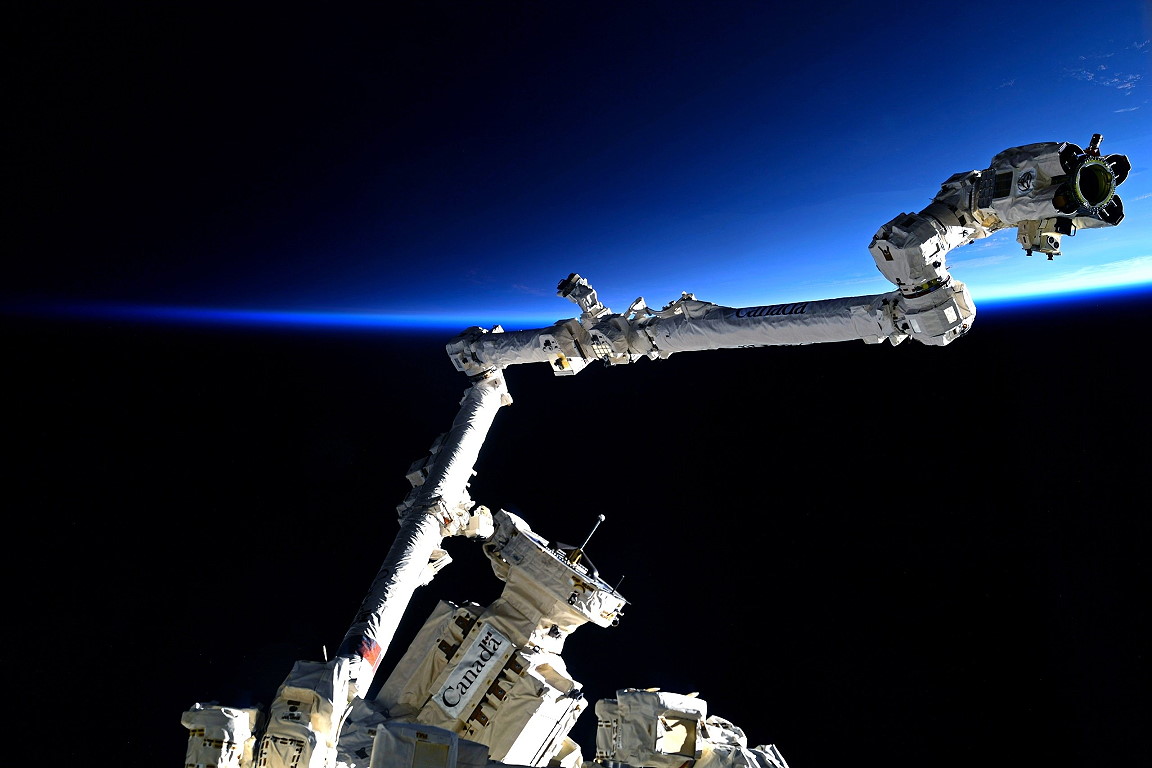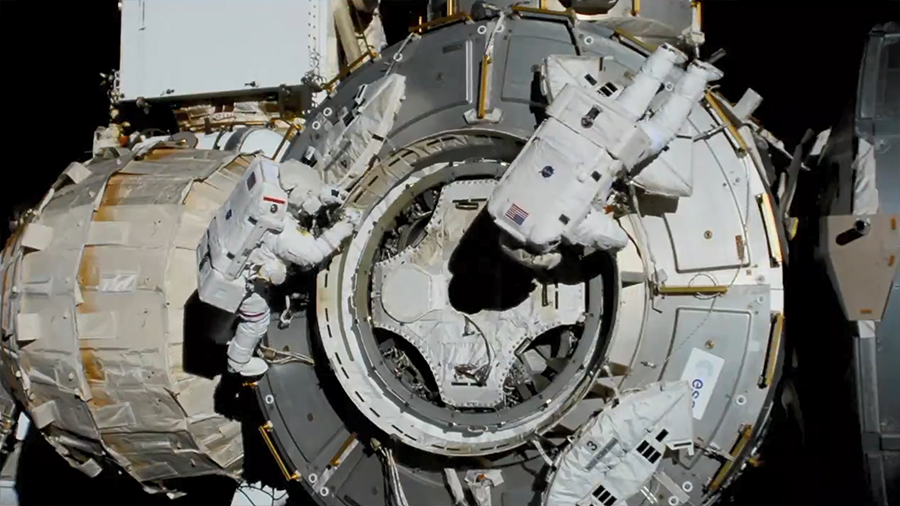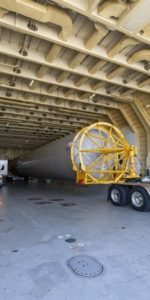
As the International Space Station (ISS) approaches 20 years of continuous habitation in a few days’ time, Expedition 63 officially came to an end at 8:54 a.m. local time on 22 October (10:54 p.m. EDT on the 21st) when Soyuz MS-16 touched down safely on the barren steppe of central Kazakhstan. Veteran NASA astronaut Chris Cassidy and his Russian crewmates Anatoli Ivanishin and Ivan Vagner wrapped up an event-filled increment which had lasted 195 days, 18 hours and 49 minutes, traveled in excess of 83 million miles (133.5 million km) and circled the Home Planet over 3,100 times.
On the day before landing, Cassidy—a former U.S. Navy SEAL—paid poignant tribute to fellow SEAL Bill Shepherd, who commanded the very first ISS expedition all those years ago.

“It has been an honor to have command of @Space_Station for Expedition 63,” Cassidy tweeted on Tuesday. “Twenty years ago, my astro-SEAL mentor, Captain Bill Shepherd, assumed command of Expedition 1. Now we are bookending those two decades of manned ISS operations with @US_NavySEALS astronauts in space.”
He also paid tribute to another former SEAL, Dr. Jonny Kim, who completed Astronaut Candidate (ASCAN) training earlier this year and was earlier this summer working medical issues in the Astronaut Office as he awaits his first flight assignment. “I wonder what @JonnyKimUSA will be in command of in 2040?” Cassidy wondered. “The first Mars outpost, perhaps?”

On Tuesday afternoon, Cassidy formally relinquished the helm of the ISS to Expedition 64 Commander Sergei Ryzhikhov, who flew to the station aboard Soyuz MS-17 with crewmates Sergei Kud-Sverchkov and NASA’s Kate Rubins last week.

“Expedition 63 has gone by super-fast,” Cassidy reflected. “We joke around that there’s only Mondays and Fridays and it’s a big blur of time between. When we started the mission, the pandemic on Earth was just starting and now we’re returning to Earth and our fellow crewmates had to train through those six months.”

The outgoing commander noted a “very interesting” half-year, with some time as a three-person crew, some time as a six-person “handover” crew—at the start and at the end—and, of course, a two-month period as a five-man increment, with the extended stay of Dragon Endeavour astronauts Doug Hurley and Bob Behnken.

“Sprinkle in there some spacewalks and some Progress cargo vehicles and some American cargo vehicles and some crazy situations with the space station systems and it’s been an incredible six months of our lives,” added Cassidy. Crazy, in fact, would be an understatement.

Cassidy was only assigned to fly this mission in October 2019 and his original Russian crewmates—Andrei Babkin and the unfortunate Nikolai Tikhonov—were grounded in February, only weeks before launch. It was reported that Tikhonov, already bumped from three previous Soyuz crews, had sustained an eye injury and left the cosmonaut corps for medical reasons later in 2020. Since the two Russians trained as a commander/flight engineer duo, both were accordingly replaced by their backups, Anatoli Ivanishin and Ivan Vagner.

Launched aboard Soyuz MS-16 from the Baikonur Cosmodrome in Kazakhstan on 9 April, Cassidy, Ivanishin and Vagner became the first humans to ride Russia’s uprated Soyuz-2.1a booster and completed a smooth docking at the ISS about six hours later. They were greeted by the incumbent Expedition 62 crew of Commander Oleg Skripochka of Russia and NASA astronauts Drew Morgan and Jessica Meir.

Having worked together as a six-person crew for a week, Skripochka, Morgan and Meir returned to Earth in their Soyuz MS-15 spacecraft on 17 April, whereupon Cassidy assumed command of the station and Expedition 63 formally got underway.

Six weeks later, on 31 May, Dragon Endeavour arrived at the ISS, amid great fanfare, to mark the first mission by U.S. astronauts aboard a U.S. spacecraft and launched from U.S. soil since the end of the Space Shuttle Program in July 2011. Demo-2 crewmen Doug Hurley and Bob Behnken expanded Expedition 63 to a five people for the next eight weeks, during which time the new arrivals assisted with a heavy scientific research workload and supported no fewer than four sessions of Extravehicular Activity (EVA).

These spacewalks, performed by Cassidy and Behnken, totaled 23 hours and 37 minutes and saw the successful replacement of aging nickel-hydrogen batteries with smaller, lighter and more powerful lithium-ion batteries for the station’s starboard-side S-6 truss.

Cassidy and Behnken also labored to prepare the ISS for upcoming power system upgrades and the arrival, later this year, of NanoRacks’ commercial Bishop airlock. In doing so, the two men joined spacewalking supremos Mike Lopez-Alegria and Peggy Whitson as the only Americans to have logged as many as ten EVAs apiece.
With the departure of Hurley and Behnken on 2 August, Cassidy & Co. remained aboard the space station as a three-man crew for the next 2.5 months. During that time, they supported a wide range of research investigations, successfully identified and temporarily halted a leak in the Zvezda service module and welcomed Northrop Grumman Corp.’s NG-14 Cygnus cargo ship, named in honor of fallen STS-107 hero Kalpana “K.C.” Chawla.

All told, during their six months aloft, Cassidy, Ivanishin and Vagner have welcomed two crewed vehicles in May and October, two Russian Progress cargo ships in April and July, Japan’s H-II Transfer Vehicle (HTV) in May and the NG-14 Cygnus in October.

But even as the final hours of their 196 days in space slipped away, the workload did not end. Cassidy wrapped up his final Sudoku puzzle—having completed one of these brain-teasers every day—and with Ivanishin and Vagner checked out Soyuz MS-16 for the ride home. “What is the price of a return ride back to Earth?” he rhetorically asked the Twitterverse on Wednesday. The answer: eight tubes of blood samples, seven of which were drawn that morning and one more due just before undocking. A space station skipper’s job, it seemed, was never done.

Until, that is, the time came for undocking and departure. After final farewells with Ryzhikov, Kud-Sverchkov and Rubins, the hatches were closed at 4:24 p.m. EDT Wednesday. Soyuz MS-16 separated from its berth at the space-facing (or “zenith”) port of the Poisk module at 7:32 p.m. EDT to commence the 3.5-hour return to Earth. The spacecraft performed its critical deorbit “burn”, lasting a little more than four minutes, at 10 p.m. EDT and its spherical orbital module and cylindrical instrument section were discarded shortly afterwards.

This left only the beehive-shaped descent module—with Cassidy, Ivanishin and Vagner inside—to endure the furnace of atmospheric re-entry. Thirty minutes after the burn, the capsule attained “Entry Interface” at an altitude of 400,000 feet (122 km) as aerodynamic heating on Soyuz MS-16 climbed to its peak and imposed thermal loads on the base heat shield as high as 1,500 degrees Celsius (2,700 degrees Fahrenheit).

Passing through the worst of the heating, at an altitude of 6.2 miles (10 km), the process of deploying the parachutes got underway: first a pair of pilots, then a drogue and finally the main canopy unfurled to its maximum size of 10,700 square feet (1,000 square meters) to bring the men of Expedition 63 to a soft landing on the desolate Kazakh steppe. “Soft”, that is, if one discounts the firing of solid-fueled braking rockets just before touchdown, which often create the disconcerting impression of an explosion.

Touchdown occurred near the copper-mining city of Jezkazgan and recovery forces quickly extracted Cassidy, Ivanishin and Vagner from the spacecraft. Wrapping up his third mission, Cassidy has now logged just shy of 378 days in space, making him the 34th most experienced spacefarer in the world and the fifth most experienced American astronaut. And with ten EVAs across his career, totaling more than 54 hours, Cassidy also sits within the Top Ten most seasoned spacewalkers of all time.

Ivanshin closes out his third long-duration ISS mission and has now accrued over 476 days of space-time, making him the 25th most experienced spacefarer in the world, whilst Vagner wraps up his first mission and leaves a lasting legacy, in particular, for his stunning Earth photography.





